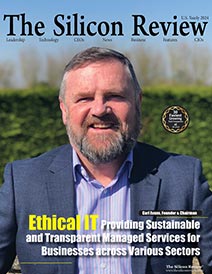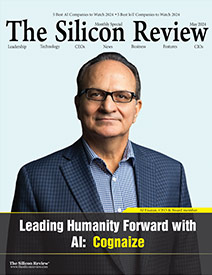A Communication and Payment Technology Company: Intelligent Contacts Merges Compliance and Consumer Convenience to Supercharge Revenue Recovery
The Silicon Review
![]()
Founded a little over 10 years ago and based in Plano, Texas, Intelligent Contacts has grown from a technology startup to an enterprise-level cloud contact center provider, as well as a PCI-DSS Level I and HIPAA HITECH-certified provider of innovative payment solutions for the financial services and healthcare industries.
Known for its modern design and “non-techie” user interface, Intelligent Contacts’ cloud-based communication and payment software can be fully deployed in days—not months.
The company’s Hosted Contact Center and Intelligent Portals deliver the personalized, automated, and fully-mobile convenience consumers want when communicating (voice, text, email, chat) or paying a bill on their schedule.
To highlight and further understand what Intelligent Contacts stands for and seeks to explore in this segment, I sat down with Jeff Mains (President), who serves as the company’s Chief Executive Officer. Below is an excerpt.
Head to Head with Jeff Mains, President and CEO of Intelligent Contacts
Q. From your perspective, how is the industry you serve currently evolving? And what are the trends in the different categories?
As an enterprise contact center software provider, we serve a wide range of industries that seem to evolve at different speeds and gravitate in slightly different directions. However, there are two significant trends that we’re seeing across these industries—whether it’s third-party receivables or the large revenue cycle management companies we serve.
I would call the first trend “consumerism,” because it’s being driven by consumer demand for convenience and self-service. In just the last five years, there’s been a major shift in how consumers approach paying their bills and managing debt. Consumers are increasingly motivated by convenience and self-resolution. As a communication and payment technology company, we know this from analyzing millions of payment transactions and communications and interactions between companies and consumers.
Consumerism is now driving the evolution of the entire Accounts Receivables Management (ARM) industry. Centralized billing offices, which typically manage receivables 20-30 clinics or physicians groups, have operated primarily as outbound call centers laser-focused on collecting patient balances over the phone. However, consumer behavior has changed. The likelihood of a consumer answering a phone call today is a fraction of what it was even five years ago. While at the same time digital communication between businesses and consumers has skyrocketed.
Consumers today avoid communication and payment channels that aren’t convenient, flexible, and accessible 24/7. The growing consumer preference towards digital communication is making one-channel call center operations obsolete.
To get the results their clients expect, our centralized billing office clients have been using all of the communication channels our contact center platform provides—including chat, email, and text.
The same is true with the revenue cycle departments of healthcare systems and the collection units of government institutions. Each category within the ARM industry is rebuilding the communication and collection process around the consumer’s preferred channel.
The second trend is process automation driven by data. Our clients are sitting on treasure troves of data, and they want to use that data to deliver better services, become more profitable, and grow their businesses.
We’ve taken a proactive approach to help our clients gain insights from that data. Through real-time performance dashboards and data modeling, our clients are improving results by delivering preferred channel communication and personalized payment options.
Since all of our communication and payment software is cloud-based, we’re also able to leverage AI and machine learning to transform all of these consumer interactions into predictive behavioral models that boost productivity and increase connection and collection rates.
Q. Given how frequently circumstances change, what plans for transformation are you pursuing to remain relevant now and in the future?
As a technology company, you have to do more than react to changes in the industries you serve. You have to anticipate what’s on the horizon and strategically plan how to tackle future challenges. At the same time, you want to address change from a position of offense and not a defense. Technology should not only fix the problems your clients are facing, it should create new opportunities that emerge out of a changing marketplace.
A major transformation we’ve already begun involves helping our clients manage consumer data better. As a provider of omnichannel contact center software, our technology touches almost every consumer interaction within a contact center. Whether that interaction is a phone call, an email, a text, or even a chat, giving our clients the ability to track and analyze each of those data points is incredibly beneficial. From a performance standpoint, that data provides insights into operational KPIs critical to success. Through data analysis, a company can answer many of the “whys” behind the bottom-line results, and take precise and immediate actions to improve those results.
Today, only a handful of our clients are fully leveraging call center data to recognize trends, shift strategies, and achieve better results. However, we’ve seen a major industry-wide tilt in that direction this year. With thinning profit margins and a somewhat erratic labor market, companies are looking to technology and big data to gain a competitive advantage.
With the 2021 release of our newest universal API, our clients have seen that competitive advantage supercharged. With that release, our clients have open access to write directly to our lightning-fast rest API to send and receive contact center data in real-time. For our clients, this new open API provides direct and immediate integration with any of the parallel systems in their technology stack.
Real-time access to contact center data is a gamechanger for many of our clients for several reasons. First, it allows our clients to keep data synced between both consumer-facing and non-consumer-facing environments. Second, it provides a critical pathway for expanded applications of machine learning and AI in the ARM industry.
FinTech is constantly evolving, but we’ve continued to stay relevant because we’ve embraced a one-size-fits-one approach when building or enhancing our software. This allows us to sell a solution instead of a product. This “solutions sales” approach puts our clients in the hero role, not us.
Q. Can you give a recent example of how your company addressed change that impacted your clients?
One of the industries we serve is Accounts Receivable Management. A significant branch within ARM— first and third-party debt collection—is one of the most heavily-regulated industries in the US. Government agencies like the Consumer Financial Protection Bureau (CFPB) and federal laws like the Federal Debt Collection Protection Act (FDCP) and Telephone Consumer Protection Act (TCPA), have specific laws and regulations that directly impact debt collection. Complying with all of these rules is a constant challenge for our debt collection clients.
Late last year, the CFPB issued its final ruling in regards to communications between a debt collector and a debtor, Regulation F. The ruling, which went into effect on Nov. 30, 2021, sent shockwaves throughout the industry. The rule outlined very specific limits on the number of times a consumer could be contacted or communicated with, and the frequency of those interactions per seven days and 30 days.
Our clients had to adapt their entire operational strategy around these new set of rules. Even with a full year to implement, many of our clients and their compliance teams were struggling to get their heads around how these new regulations could be technically managed. We immediately began working on fundamental enhancements to our solutions that would provide crucial guardrails to comply with these new rules and limitations. Although the ultimate compliance burden rested with our clients, the majority of 2021’s development efforts focused on helping solve this problem.
Because of the stellar work of our development and client success teams, we were able to deliver the essential compliance enhancements to our clients before the Nov. 30 deadline.
Jeff Mains | President and CEO
Over the last two decades, Jeff Mains has led several international software and professional services companies. An expert at turning good ideas into great enterprises, Jeff has built five companies from nothing and sold four of them (so far) to Fortune 1000 giants. He’s turned three more floundering businesses from a downward spiral to soaring performance and played a part in 23 merger and acquisition deals. Currently, he is the president and CEO of Intelligent Contacts, an international communications, and payments company that helps healthcare organizations create great patient experiences on the business side of healthcare (like appointments, claims, and billing).









